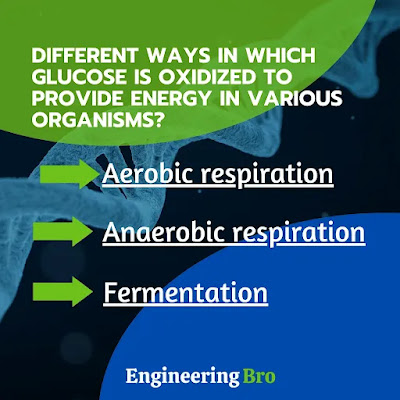- Aerobic respiration
- Anaerobic respiration
- Fermentation
Glucose is a simple sugar that serves as a primary source of energy for many organisms.
The process of oxidizing glucose to produce energy is known as cellular respiration.
What are the different ways in which glucose is oxidised to provide energy in various organisms?
Cellular respiration involves three main stages:
- Glycolysis,
- The citric acid cycle,
- The electron transport chain.
- While the overall process is similar in all organisms, there are some variations in the way that glucose is oxidized to provide energy.
Here are some of the different ways in which glucose is oxidized to provide energy in various organisms:
- Aerobic respiration: Aerobic respiration is the most common way that glucose is oxidized in eukaryotic organisms, including animals, plants, and fungi. Aerobic respiration occurs in the presence of oxygen and involves the breakdown of glucose through glycolysis, the citric acid cycle, and the electron transport chain to produce ATP, the primary energy currency of cells.
- Anaerobic respiration: In some organisms, such as bacteria and yeast, anaerobic respiration occurs in the absence of oxygen. Anaerobic respiration also involves the breakdown of glucose through glycolysis, but the electron transport chain is replaced by other electron acceptors, such as nitrate or sulfate. Anaerobic respiration is less efficient than aerobic respiration, and it produces fewer ATP molecules.
- Fermentation: Fermentation is another way that glucose can be oxidized to provide energy in the absence of oxygen. Fermentation involves the breakdown of glucose through glycolysis, followed by the conversion of pyruvate to either lactate or ethanol and carbon dioxide. Fermentation is less efficient than aerobic respiration and produces only two ATP molecules per glucose molecule.
- Photosynthesis: In photosynthetic organisms, such as plants and algae, glucose is not oxidized to provide energy. Instead, these organisms use light energy to convert carbon dioxide and water into glucose through a process known as photosynthesis. The glucose produced through photosynthesis can then be oxidized through aerobic respiration to produce ATP.
In summary, the process of oxidizing glucose to provide energy is a fundamental process in many organisms. While the overall process is similar in all organisms, there are some variations in the way that glucose is oxidized to provide energy, depending on whether oxygen is present or absent, and whether the organism is photosynthetic or not.

